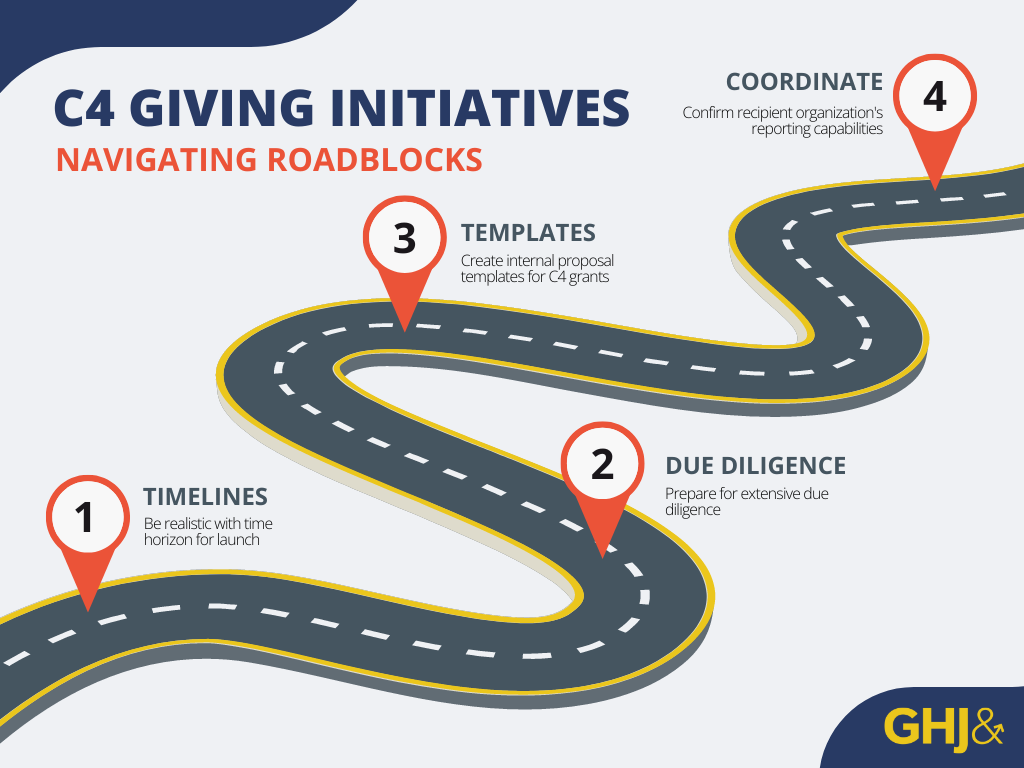Most private foundation grants support the charitable work of 501(c)(3) nonprofits, but a growing number of funders — including the California Wellness Foundation — are moving beyond traditional grantmaking to support 501(c)(4) organizations as an additional strategy to expand advocacy for social impact.
Cal Wellness is one of the state’s largest health foundations, with a mission to protect and improve the health and wellness of all Californians by increasing access to healthcare, good jobs, healthy environments and safe neighborhoods. Because racism is a driver of health inequities, Cal Wellness invests in amplifying the voices, leadership and power of people of color advocating for health justice.
The foundation began this new area of grantmaking through providing grants to C4s that were sister organizations of existing C3 grantees working to increase civic participation in communities of color.
Cal Wellness has lessons learned and best practices to share, including the importance of internal buy-in, conducting due diligence and new processes for managing a different type of grant with more strict monitoring requirements.
Few private foundations are set up to fund 501(c)(4) organizations due to the potential excise tax that a foundation may be subject to, along with the additional oversight that is required.
“Many of GHJ's private foundation clients are more curious about venturing into C4 giving,” said GHJ Nonprofit Tax Practice Leader Lizbeth Nevarez. “California Wellness Foundation is among the first to do this.”
THE IMPORTANCE OF FUNDING 501(c)(4) ORGANIZATIONS
According to the IRS, 501(c)(4) organizations are considered social welfare organizations “promoting in some way the common good and general welfare of the community.” C4 organizations are allowed to engage in partisan political activity as long as at least 60 percent of their work is for the organization’s social welfare purpose, according to the Alliance for Justice, which advises foundations on advocacy grantmaking.
“The most important distinction for private foundations to note is that C4 contributions are not considered qualifying distributions for private foundations,” Nevarez said. “In order for a grant to a C4 to be considered a qualifying distribution, the grant funds must be for a charitable purpose and the Foundation must undertake expenditure responsibility.”
Cal Wellness Program Director Earl Lui said the foundation’s interest in C4 funding “began as a natural outgrowth of our existing work in the civic engagement area. We were already funding a lot of civic engagement C3s.”
After a few years, the foundation learned more about the sister 501(c)(4) organizations of these groups.
“We heard that it was hard to build these C4 organizations because funding primarily came during election years,” Earl said, noting the activities of C4s often go beyond election activities and provide impactful services to the community year-round.
These C4s could ramp up work during these periods, but they could not retain staff or grow operations when funding dried up in between election cycles.
"We saw an opportunity to provide funding to help stabilize their core operations and become more sustainable organizations,” Earl explained.
GETTING BUY-IN ACROSS THE FOUNDATION TO LAUNCH
Adding C4 grantmaking requires clarity of purpose, internal buy-in, due diligence and processes for monitoring grantee expenditures. Cal Wellness recommends these best practices to start the conversation, get stakeholders on board and prepare for implementation.
Have a Clear Strategy: Foundations should be clear about why they are undertaking C4 funding, how it advances their mission and what can be accomplished through C4 support that is not possible through C3 funding.
Engage Board and Staff: Cal Wellness started with an internal learning session led by the C4 sister organizations of C3 partners. “They talked about the importance of funding C4 work and of having those flexible dollars,” explains Cal Wellness Program Officer Marisol Inzunza.
Learn from Fellow Funders: Cal Wellness grants management and operations leaders spoke with colleagues at several foundations to learn about how they approached C4 funding, including what was effective and lessons learned.
Work Across the Foundation: At the staff level, there were a lot of internal conversations with the grants management and finance departments.
“There is a heightened sensitivity to C4s with all the rules you have to follow to avoid excise tax and avoid any prohibited activities such as lobbying and electioneering,” Earl said. “It raised a lot of alarm bells for staff.”
Consult with Outside Legal Counsel: Cal Wellness worked with two lawyers at an external firm, both of whom were supportive and helpful.
Find Knowledgeable Partners and Advisors: Foundations can also mitigate risk along the way by partnering with other external experts. “C4 funding requires a strong degree of collaboration in order to work,” Lizbeth said.
The California Wellness Foundation worked with Alliance for Justice's Bolder Advocacy program, which provided internal training to help with the new project. The organization's staff attorneys conduct both group workshops as well as one-on-one assistance for foundations and nonprofits.
Develop New Policies and Procedures for C4 Grants: Foundations need a more detailed due diligence and monitoring process to ensure IRS compliance. Cal Wellness redesigned its expenditure responsibility reporting processes in preparation for making C4 grants. The foundation developed staff training sessions specific to this new type of grant to make sure new processes were communicated and clearly understood.
“C4 grants are expenditure responsibility (ER) grants,” Earl said. “We have adapted our policies and procedures that we had in place for normal ER grant-making to adapt some of those to the more stringent issues regarding C4s.”
Evaluate Processes: Foundations should routinely adjust processes based on what is working well and what needs to improve.
C4 grantmaking requires extensive collaboration and partnership between grant-makers, the grants management team and the finance department.
A grantmaker's checklist for C4 giving should include things like:
- Required documents
- Proposal materials
- Funder references
- Project budgets
- Assessment of grantee reporting capabilities
NAVIGATING ROADBLOCKS
Launching a C4 giving initiative is not a straightforward path, but there are steps foundations can take to avoid potential pitfalls.
Be Realistic with a Time Horizon: Foundations should anticipate a lengthy launch process before actually allocating funds to C4s. Getting that initial buy-in from the board and staff takes time. There are a lot of internal questions to answer, and new processes may be required.
“Be patient,” Marisol advises. “It cannot be done in a couple of months. For Cal Wellness, it took about a year.”
Prepare for Extensive Due Diligence: Once a foundation has internal buy-in, the due diligence process also takes time. Schedule meetings and take the time to address concerns across the organization. It is important for all staff members and key management individuals to fully understand the potential risks in funding C4 organizations. Having a well-informed grants team is key in avoiding any potential excise tax on the foundation.
Create an Internal Proposal Template: The proposal process may look different for C4s, and will require different kinds of due diligence. The foundation's grants management staff needs to work with the grantmaking team to make sure the grantee's story is clearly communicated and the charitable purpose is clearly outlined.
Confirm the Recipient Organization's Reporting Capabilities: Not all C4s have the ability to accept foundation funding or the capacity to follow the extra compliance required for C4s. Funders need to be certain that C4 grantees have the capability to track and account for spending to demonstrate that foundation dollars are not used for prohibited activities. Strict rules are required in the following areas:
- Restricted vs. Unrestricted Funds: The organization must be able to track and segregate restricted funds (those given for a specific purpose) from unrestricted funds. This ensures that the funds are used according to donor intentions.
- Grant Agreements: The 501(c)(4) must have the capability to manage and comply with the terms of grant agreements, including tracking how funds are spent, reporting on outcomes, and adhering to any restrictions imposed by the funder.
- Financial Controls: Strong internal controls are necessary to prevent misuse of funds, including policies for authorizing expenditures, ensuring accurate financial reporting, and conducting regular audits.
“The reality is that the organizations we made our first grants to are pretty sophisticated,” Earl said. “They understand what grant funds can be used for and what activities cannot be funded.”
It is too soon to measure the impact of specific C4 grants, but The California Wellness Foundation’s leadership is already creating change within the private giving community.
“As one of the first private foundations to make C4 grants, we have had an impact in paving the way for others through showing what is required for this kind of grantmaking and demonstrating to the field that it can be an effective strategy,” said Cal Wellness Vice President of Operations Arun Baheti.
C4 giving is an opportunity for foundations to expand their impact. They can ensure long-term success (and IRS compliance) by doing the heavy lifting upfront. This includes fostering internal buy-in and creating foundation-wide systems for monitoring and compliance.
| GHJ’s Risk Management for Private Foundations Series: Navigating Challenges and Seizing Opportunities dives deep into the risks that private foundations face and offers practical solutions across a spectrum of areas including automation, cybersecurity and new giving strategies. Gain insights into implementing new ideas, ensuring compliance and exploring innovative partnerships to enhance impact. Learn more. |



